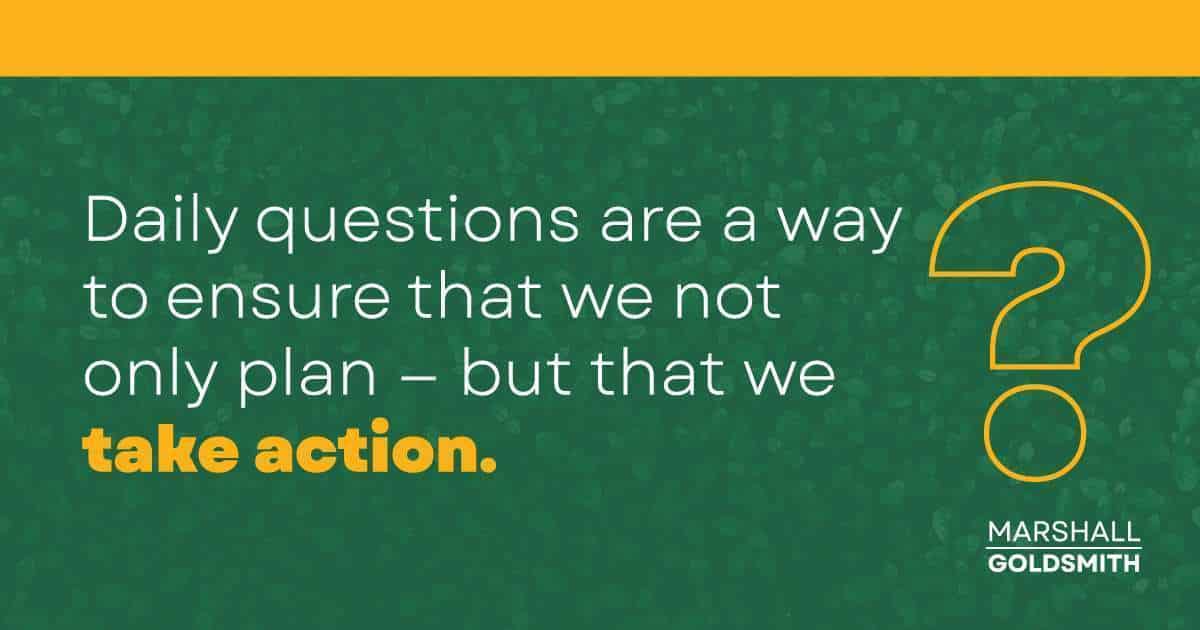Playing Favorites By Marshall Goldsmith There’s a reason I devote...
One of the most important parts of creating a fulfilling life, an earned life, is figuring out your path and sticking to it. How do you do that? How do you gain insights into the right next steps? In my coaching career, I have learned a lot from mentors, customers, friends, and teachers, and I have used several of them to formulate my coaching going forward. These are the concepts of:
Here, I’d like to explore the notion of the daily questions.
Many of us make to-do lists every day to ensure that we’re getting things done. But how many of us reflect on how we’ve spent our day? How many of us review the lists of things to do and determine how we’ve accomplished them, or if we’ve managed to spend the day as produc- tively as we liked?
I have found that daily questions are a way to ensure that we not only plan but that we take action. Over the years, as I’ve incorporated such concepts and activities into my coaching as the referent group, the notion of feedforward, stakeholder-centered coaching, the business plan review, and the “what’s next” weekend, I’ve also found that daily questions are a powerful way to keep people on track.
The fact is, we are superior planners and inferior doers. Daily Questions is the tool I picked up a decade and a half ago to deal with my repeating pattern of well-meaning intention followed by unreliable execution.
I explained it in detail in my book, Triggers, and I included a list of the twenty-two questions that test my daily resolve to match execution with intention, doing with planning.
The key: Each question begins with “Did I do my best to…” followed by a specific goal such as, “Set clear goals?” and “Exercise?” and “Not waste energy on what you cannot change?”
At the end of the day, I score each question from a low of 1 to a high of 10, based on how well I tried.
The process measures effort, not results.
We can’t always control the outcome, but all of us can try. Some years ago I hired a coach, because I need help sticking to the plan. The coach calls me each evening for my scores. It’s the best enforcement routine I’ve come across for earning a desired outcome. But it can be painful; it’s disheartening to regularly post 1s and 2s for goals that you claim really matter to you. The pain eventually leads to giving up. But if you stay with it, it works. For anything.

The morning question | 5 | Rise, wash and address Powerful Goodness |
What good shall I do today? | 6 | Contrive day’s business and take the resolution of the day |
7 | Prosecute the present study. Breakfast. | |
8 | ||
9 | ||
10 | Work | |
11 | ||
12 | Read, or overlook my accounts, and dine. | |
1 | ||
2 | Work | |
3 | ||
4 | ||
5 | Put things in their places | |
6 | Supper, music, or diversions or conversation | |
7 | Examination of the day. | |
8 | ||
9 | ||
Evening questions. | 10 | |
What good have I done today? | 11 | |
12 | ||
1 | Sleep | |
2 | ||
3 | ||
4 |
I didn’t invent this. Credit goes to Ben Franklin, America’s founding father of self-improvement (“A penny saved is a penny earned”).
In addition to including a daily to-do list in his Autobiography (“Rise, wash, and address the Powerful Goodness; contrive day’s business and take the resolution of the day; prosecute the present study; and breakfast”), Franklin also described a longer-term self-monitoring regimen. He listed 13 virtues that he wanted to perfect within himself. (Temperance, Silence, Order, Resolution, Frugality, Industry, Sincerity, Justice, Moderation, Cleanliness, Chastity, Tranquility, Humility.)
Rather than tackle all 13 at once (the quintessential unrealistic goal), Franklin chose one value at a time and fixated on it until he mastered it. Every time he faltered, he marked it down in a book, then added up the blemishes at day’s end. When the total came to zero, he declared victory and moved on to the next virtue.
Although the routine is more than 250 years old, it’s still very contemporary. (It reminds me of NBA sharpshooter Steph Curry’s Rule of 100 shooting drill: Curry practices jump shots from five spots on the court, not moving on to the next spot until he sinks twenty shots in a row. One miss and he restarts at zero.)
It’s the inspirational foundation for Daily Questions.
Adding Too Much Value Won’t Get You There By Marshall...
C-Suite Master Class: No, But, However By Marshall Goldsmith Continuing...
The Doerr Institute: Expanding the Market for Coaches By Marshall...
Making Leadership Development Part of the College Degree at Rice...
Sanyin Siang – Winner of the Thinkers50 Marshall Goldsmith Coaching...
Thinkers50 Marshall Goldsmith Distinguished Achievement Award in Coaching – Nominees...
Leading with Influence: What Is Influence360°? By Marshall Goldsmith Founder...
Are You a Dominator, Manipulator, Persuader or Influencer? By Marshall...
Leading with Influence: Redefining Modern Influence Part 2 By Marshall...
My mission is simple. I want to help successful people achieve positive, lasting change and behavior; for themselves, their people, and their teams. I want to help you make your life a little better. With four decades of experience helping top CEOs and executives overcome limiting beliefs and behaviors to achieve greater success, I don’t do this for fame and accolades. I do this because I love helping people!
As an executive educator and coach, I help people understand how our beliefs and the environments we operate in can trigger negative behaviors. Through simple and practical advice, I help people achieve and sustain positive behavioral change.